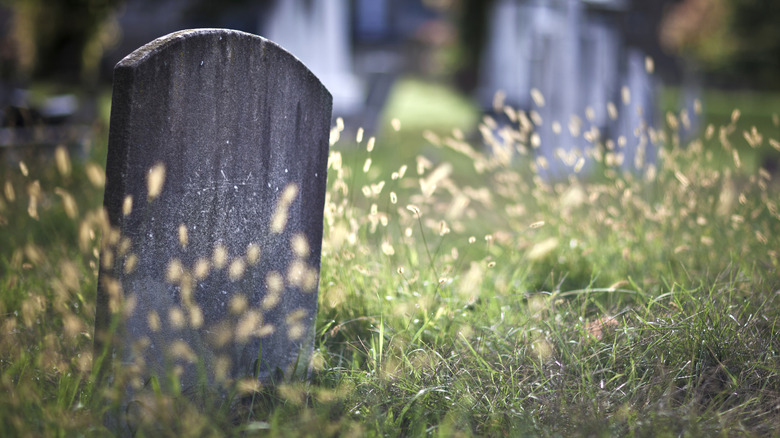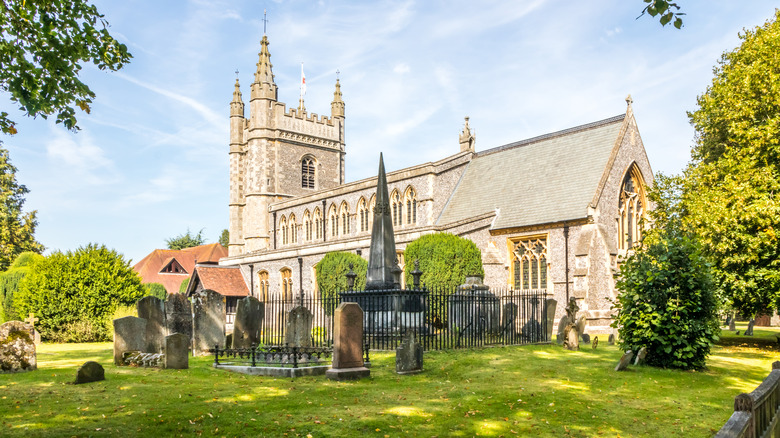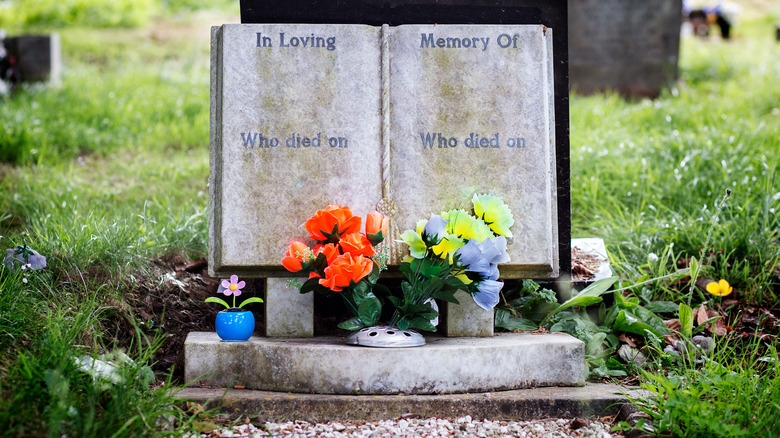Cemeteries Vs. Graveyards: What's The Difference?
Sometimes words get used interchangeably without a second thought, but if we give those words a second thought, we might realize that something isn't quite right. Such is the case for the words graveyard and cemetery. We visit them, pass by them on walks or drives, and talk about them from time to time, especially during the Halloween season. For some, these places bring feelings of peace, while others can't help but get the creeps and a strong desire to steer clear.
Graveyards and cemeteries are, in fact, two different things. The titles themselves generally approximately the same end result. The word graveyard comes from the proto-Germanic word graban — to dig, as explained in an article on Cake, and cemetery comes from the Greek word koimeterion, meaning dormitory or sleeping place, via Locust Valley Cemetery. While yes, the names are sometimes used interchangeably, and both are places where people are laid to rest after they die, the history that's stacked behind the two burial sites is unique to each one.
It's all about the location
While there are many similarities between graveyards and cemeteries, such as the fact that the dead are buried there, there are a few notable differences as well. One of these is location. When looking at a vast plot of land adorned with headstones and winding walking paths leading visitors to their loved ones, what you're looking at is a cemetery. But, on the other hand, a graveyard is a much smaller plot of land that's almost always part of the grounds of a church, as reported in an article on Cake.
At one point, the church was the only entity allowed to bury someone after death, and only in churchyards. However, by the end of the 18th century, population growth caused the health risks of the overpacked churchyards to become impossible to overlook. This led to the beginning of garden cemeteries, according to Locust Valley Cemetery. These garden cemeteries not only provided more space, but they were also the beginning of burials without church involvement, as government agencies and private companies ran them.
Religious guidelines play a role regarding which you can be buried in
Whether you're in the market for a burial plot or not, it's good to know that how you live your life can dictate where you're able to be buried after death. According to HuffPost, before population became an issue, the wealthy and prominent members of society were able to be buried inside churches, either under the floor or in a crypt, while the less affluent were buried outside in the churchyard, which also eventually got tight on space. Today, graveyards are typically connected to a specific worship space, so it's no surprise that they come with religious affiliation.
With such limited space, graveyards sometimes are slightly more strict about who they allow to be buried there. In some cases, the requirements for burial in a graveyard include that a person has to have been a member of that particular religion, and sometimes they even need to be a member of that very church. Cemeteries are much more lenient, however, and allow both religious and non-religious people to be buried there, as explained by Cake.
Graveyards have more strict rules for their appearance
Religious guidelines aside, there are still a few key rules to burying someone in a cemetery compared to a graveyard. A lot of it lies with aesthetics. Graveyards tend to be on the conservative side and generally frown upon elaborate markers and headstones. According to an article published in Cake, it isn't uncommon for graveyards to require headstones to be neutral in color and made of only stone or granite. These requirements might add to the eerie look that people often associate with graveyards. Inscriptions on the headstones may also be checked to make sure they're in line with the religious values of that church. According to Pulvis Urns, graveyards may also have specific requirements when it comes to the appearance of an urn that's being buried on the grounds if a person has been cremated.
On the other hand, cemeteries tend to be much more relaxed with their looks and requirements. Large and elaborate memorials are neither uncommon nor discouraged, and headstones may come in many finishes and color schemes. One thing the two sites do have in common is that at both cemeteries and graveyards, the upkeep of the headstone is the responsibility of the deceased's loved ones.
Both serve as peaceful resting places
With all the differences between the two, it's essential to keep in mind that both cemeteries and graveyards serve as peaceful places for those who've died, and where their loved ones can pay their respects. In addition, cemeteries may have been the perfect answer to population growth, as they brought new freedom to burials that weren't established when only churches were allowed to perform the task.
No need to be worried about population causing the same space issue again, either, as both graveyards and cemeteries typically sell burial plots for anywhere between 50 and 100 years, and even after those decades pass, it's unlikely a body will be moved unless it's an absolute necessity (via Mountain View Funeral Home and Cemetery). So whether you're curious about your own future burial site, a loved one's, or simply an adventurous explorer taking in the history and energy that these places have to offer, next time you're near either a graveyard or a cemetery, you'll know which it is.
More recently, both options have fallen out of favor
Although burial of the deceased was the preference for many years in America, increasingly, people are opting for cremation. The Washington Post reports that cremation has actually overtaken burial in terms of "final disposition."
The numbers are clear: The Post cites figures from the Cremation Association of North America (CANA), which reports that in 2020, 56% of deceased Americans were cremated, more than twice the 27% around 2000. The association is estimating that by 2040, cremations will reach 80%. Japan already sees nearly 100% cremations.
What to do with cremated remains is, of course, an issue. Presently, CANA estimates, some 20% to 40% of cremated remains end up in a cemetery or graveyard, either buried or in a columbarium, a sort of chambered area for urns, not unlike a bank's safe deposit boxes. The rest? Many times the ashes are scattered, or the urn ends up in a closet or on a shelf somewhere besides a graveyard. Or a cemetery.





